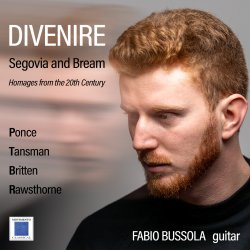
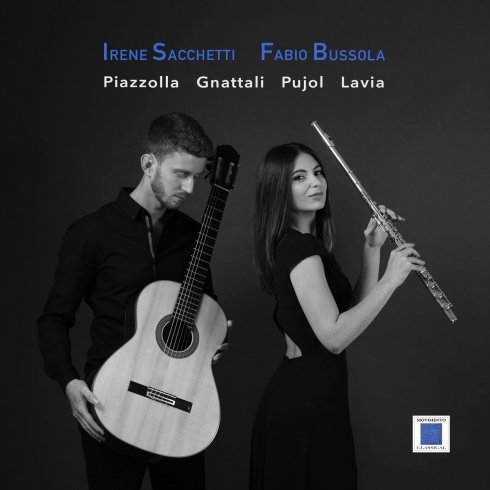
The opening of the cd is marked by the great Astor Piazzolla. Born in Mar del Plata on March 11th 1921 and, fora long time, was misunderstood and openly ignored by the officiai circles.The Argen tinian composer was a well-rounded musician, characterized by a multifaceted personality. He studied with hisfellow countryman Ginastera, but soon felt the need to complete his training in Europe by perfecting his skills in conducting with Scherchen and in music composition with Nadia Boulanger. The musician was deeply attached to his home country, he became legendary and is still considered a «symbol of an Argentina that has never been sufficiently remembered». Piazzolla embodies the very idea of tango, the most typical and sensual out of all the South American dances. lt's nota coincidence that for many people, Piazzolla is simply the tango, even if this is - upon closer inspection - a reductive conception of his music, which is full of assonance, echoes and cultured references to the great Western tradition, but also to jazz and light music.
As for the emblematic Histoire du tango (1986), it is divided into four movements which - starting from the allusive titles - intends to illustrate the evolution of tango over the decades. lt's a very ef fective and highly challenging piece, sometimes dramatic, for which uncommon interpretative skills are required; it is designed expressly for the combination of flute and guitar; it opens with Borde/, in which, according to the punctual and suggestive 'notes' by Piazzolla himself that were placed to accompany the score, the intent is to evoke the amiable chatter that takes piace in a brothel «populated by French, ltalian and Spanish women» (a recall to the habanera) engaged in making fun of policemen, thieves and sailors. In Café, the music now evokes another era; the tango has undergone a conspicuous transformation, in which, according to the author, there are «new and sometimes more melancholic harmonies». These harmonies are dreamy, but also turbid: the music then dies out in a whisper. In Nightclub there is an allusion to a «climate of international trade» in which Brazil and Argentina ideally merge in Buenos Aires and bossanova and nuevo tango coexist. In the last challenging and very arduous panel, we finally find in the background the echo of Bart6k and Stravinskij, as well as that of certain avant-gardes. lt is truly impossible not to be charmed by it. In second position, there is a piece by the Brazilian Radamés Gnattali, a pianist, composer and conductor of ltalian origin who was able to reinterpret consolidated musical forms with a decided ly persona! language. His mother - his first teacher - was a pianist, while his father, a bassoonist, later devoted himself to conducting; both of them were avid music lovers and were particularly passionate about Verdi's opera. lt really was not by chance that they chose for their children the names of Radamés, Aida and Emani, names obviously borrowed from many characters of the Bus seto composer's works. We listen to the captivating Sonatina, divided into three 'classic' move ments: a piece in which a balanced mix of folkloric dance styles and exquisitely twentieth-century elements can be admired. As to the first movement, with arabesque and, at times, dreamlike figura tions, the sophisticated harmonies and the sometimes-contrapuntal treatment should be empha sized within a conduct with a conspicuously "rhapsody" trend.Themiddle movement is notable for its chromaticism and its sweet lyricism tinged with melancholy. In the final movement, a decidedly virtuosic allure prevails, including difficult passages which are entrusted to both instruments: the flute is often engaged, on the regular and reassuring substrate of the guitar, in proposing sharp stalactites-like phrases, alternated to ones conceived as the remake of an archaic bicinium. To follow, a piece by the Argentinian Maximo Diego Pujol, a guitarist who was influenced by Piaz zolla, as well as by Villa Lobos. The four movements of the composition - respectively Pompeya, Palermo, San Telmo, Microcentro - are inspired by the very same neighborhoods in Buenos Aires. The first vivacious movement presents pressing rhythms, pungent and sometimes bittersweet harmonies; next emerges the Andante section started by the guitar, in which a certain intimism characterized by a sound of vague lberian assonances prevails. The two elements then happily coexist by alternating. From moments of greater stasis, the piece gradually regains altitude with a suggestive effect. In Palermo, a languorous climate prevails thanks to the key of E minor which makes it even more poignant: it is a muffled languor found in the major key centrai part. On the other hand, the third movement, with its clear tripartite structure, instead stands out for its care free freshness and an atmosphere of joy, embellished with refined timbrai and percussive effects. Finally, in Microcentro, the vortex of an almost perpetuum mobile figuration achieves results of sure appeal: here too, there is no lack of arcane inspired moments which are setto react with the glimmering figurations of the flute, often pushed into the high-pitchedregister. Lastly, the unreleased piece Cortes y quebradas by Sergio Fabian Lavia, a guitarist, composer and sound artist of ltalian origin born in Buenos Aires. His interests range from classical-contemporary to new technologies of popular music of Argentina and Brazil and they lead him to seek a dialogue between dissimilar cultura! worlds. Trained in his homeland, he continued his studies in Milan; after having obtained diplomas in guitar, composition, electronic music and computer science, he perfected himself with Donatoni and De Pablo. His music has been performed by important musi cians, used in video in more than forty countries around the world; he has performed with artists from different backgrounds such as Riccardo Chailly, Luis Bacalov, Vinko Globokar, Nicola Piovani, Vladimir Jurowski, Yutaka Sado and Enrico lntra. Heis the guest of recording and editoria! projects with Decca, Stradivarius, Warner Chappell, and also the artistic director of the Menaggio lnt erna tional Guitar Festival and teacher at the "Conservatorio della Svizzera italiana". Cortes y quebradas - in Spanish, "cuts and breaks" - «constitute a classic moment of the tango in which the walk is interrupted by a choreographic ornament. The 'cut' - Lavia specifies, while illus trating the linguistic and expressive peculiarities of the piece - intensifies the communication between the couple by accentuating the sensuality of the dance». lt is on this image premise that the author declares to have «created a piece with an abundance of surprises and rhythmic melodie suspensions», where there is room for the development of «typical materials of the tango and milonga cultures, scales, complex harmonies and phrases that tend towards asymmetry»; this results in a «fusion of musical elements between Buenos Aires and others of rural origin». Various virtuosic passages stand out,as well as a notable «richness of articulations»,from the use of charac teristic timbres such as the fl utt er-t on g uin g technique of the flute andthe rasgueado of the guitar. Thìs piece results in a fascinating t wo-way dialogue, inspired by the peculiar ways of the tango«which alternates the protagonism of the components to respective solos».

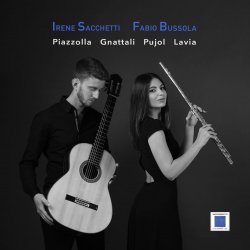
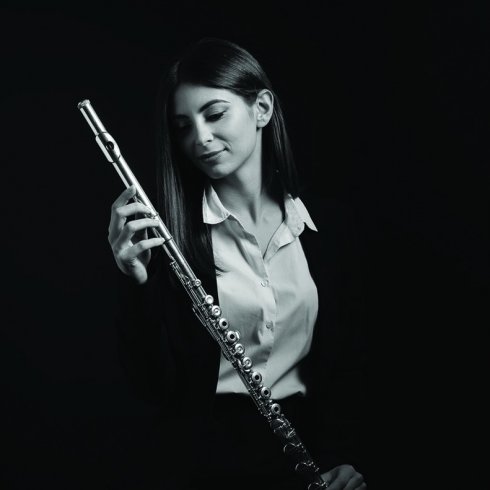
Irene Sacchetti
Born in Bergamo in 1998, Irene Sacchetti began studying flute at the age of nine with Paola Proserpi and then with Anna Facoetti. After graduating from “P. Secco Suardo” music high school in the class of Ombretta Maffeis, she continued her flute studies at the “Gaetano Donizetti” Conservatory in Bergamo with Paola Bonora, where in 2020 she graduated with full marks and honors, then specializing with Gianni Biocotino at the "Guido Cantelli" Conservatory in Novara. In parallel to the flute, she deepened the study of opera singing, followed by the singer Tiziana Fabbricini. She took part in numerous master classes with teachers of national and international caliber such as Silvia Careddu, Salvatore Lombardi, Maurizio Simeoli, Shimizu Kazutaka, Domenico Gustafierro, Marco Zoni and in Belgium with Marc Grauwels. Since 2010 she has participated and won numerous national and international flute competitions, including the award as best solo flautist at the "Civica scuola di Musica, fondazione di Milano" (MI) national competition, the First prize at the "Giuseppe Peloso" (PV) competition for young flute players, First prize at the "Lodovico Agostini" (FE) national music competition and the first prize at the “Città di Cremona” (CR) international competition. In 2017 she received the "Music and Nature" chamber music award in Switzerland, which will allow her to be a guest of important concert exhibitions. In parallel with the solo aspect, she performs in several important orchestral formations, collaborating with the Donizetti Conservatory Orchestra of Bergamo in various events in the province; thanks to it she will take part as the first flute in the International Piano Festival of Brescia and Bergamo, conducted by Fabrizio Maria Carminati. In 2018 she performed with the Sinapsi Opera Orchestra & Choir of Rome at Basilica di San Pietro in Tuscania, collaborating with soloist of clear renown and directed by Isaac Karabtchevsky. In 2019 she performed at “Hotel de Ville de Wavre” in Belgium during the “Rencontres Musicales Internationales en Wallonie”; in the same year she collaborated with Orchestra Italiana del Cinema (O. I. C.) in a series of concerts concerning film’s soundtracks, conducted by Timothy Henty and Benjamin Pope at the Teatro degli Arcimboldi in Milan, and then at the MGM Cotai Theatre in Macau (China), under the direction of Shih-Hung Young. She also performed on the award ceremony of the city of Bergamo as a UNESCO Creative City at the Palazzo Pirelli’s Salone Belvedere-Jannacci, in Milan. In 2020 she was the winner with special mention of the “Samnium University of Music Audition Awards” international competion, which will allow her to take part in a concerts tour in some of the most prestigious concert halls such as the Teatro Romano in Benevento, the Teatro di Ostia Antica in Rome and the Musikverein of Vienna. In duo with guitarist Fabio Bussola, a stable formation since 2013, she performed in numerous concert exhibitions in Italy and abroad and took part to many master classes with some of the most influential people of the field, such as Giulio Tampalini and Roberto Porroni. They won various international competitions such as the International Competition “Città di Favria” and the International Competition “Città di Cremona”. In 2016 they were invited to perform in several episodes of the television broadcast “Ciao Gente”, dedicated to young Lombard talents and then in 2017 they were selected by L’Eco di Bergamo for the series of interviews and performances “Protagonisti”. Dedicatee of composition by contemporary authors such as Marco Bussola (Atmposphère for flute and guitar dedicated to Irene Sacchetti and Fabio Bussola) and Alessandro Chiantoni, from the latter she was entrusted with the first absolute performance of the compositions “Dialogue n. 1 Op. 5” and “Chant d’Oiseaux Op. 7”, piece dedicated to her. Among the chamber formations, she took part with Quintetto Elisir in important concert exhibitions held in the province of Bergamo and Brescia, including the International Piano Festival of Brescia and Bergamo and the Aldebaran Music Festival.
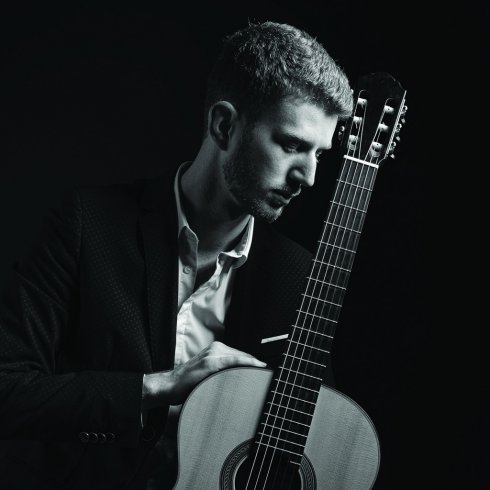
Fabio Bussola
Born in Bergamo in 1998, he began studying guitar at the age of nine with Ivan Bracchi, then attended the “P. Secco Suardo” music high school in Bergamo with the guitarist and composer Giovanni Podera and the “Gaetano Donizetti” Conservatory of the same city with Luigi Attademo. From 2015 to 2019 he studied with Andrea Dieci and Bruno Giuffredi in the “Giulio Regondi” guitar Academy in Milan. In 2020 he graduated with the highest marks, honors and special mention at the “Guido Cantelli” Conservatory of Novara. He has participated in master classes with internationally renowned teachers such as Giulio Tampalini, Frédéric Zigante, Javier Riba, Andrea De Vitis, Christian Saggese, Lucio Matarazzo, Massimo delle Cese and Marco Tamayo. In addition to performing in Italy and abroad as a soloist and in various chamber formations, he won more than twenty national and international guitar competitions, including the first prize at the 12° edition of “Città di Voghera” international competition, the first prize for two consecutive editions in “Città di Favria” international competition and the first prize with special mention in “Città di Tradate” guitar competition. In 2015 he was awarded the 29° “Lino Barbisotti” scholarship edition in Bergamo, in 2016 he won the “Mauro Fantinelli” international interpretation award and in 2016-2017, for two consecutive editions, he won with the flutist Irene Sacchetti the “Music and Nature” chamber music award in Switzerland. Since 2018 he has been the winners of several prizes and competitions, including the first prize at “Giorgio e Aurora Giovannini” guitar competition in Reggio Emilia, the first prize for two consecutive editions in “Festival Corde d’autunno” international competition in Milan, the first prize in “G. Marziali” competition in Seveso and the first prize in “La chitarra volante” national competition in Brescia. In 2019 he was awarded the “Francesco Vaccari” scholarship and he played in many guitar festivals, including the prestigious “Il Mondo della Chitarra” guitar festival in Novara, which every year hosts important international artists. In 2019 and 2020 he won for two consecutive editions the “Seicorde Academy” award, assigned by the Masters Andrea Dieci, Christian Saggese, Giulio Tampalini, Marco Tamayo and Filippo Michelangeli, the “Suonare News” and “Seicorde” director. He recently took part in a “Seicorde – I Maestri della Chitarra” recording project and will record a new CD the next year. In 2020 he won the “Giancarlo Facchinetti” award for best young performer of the “Seicorde Academy”. He recorded the works of the guitarist and composer Giovanni Podera and other works dedicated to him by contemporary composers such as Luigi Artina, Kevin Swierkosz-lenart and Franco Balliana. Many of these recordings are published for the “Sinfonica” publishing house and the “ZeroCrossingRecords” label. In 2020 he released his first video for the important german label “SiccasGuitars”, brand followed for the performance publications of famous and young guitarists from all over the world. He is currently studying at the “Guido Cantelli” Conservatory in Novara with Bruno Giuffredi.
